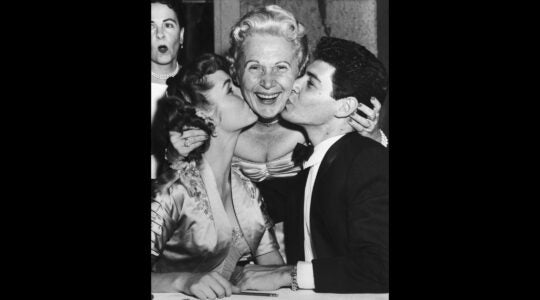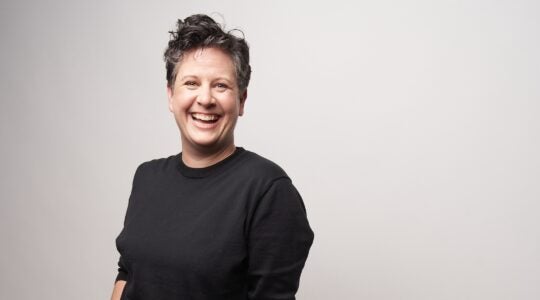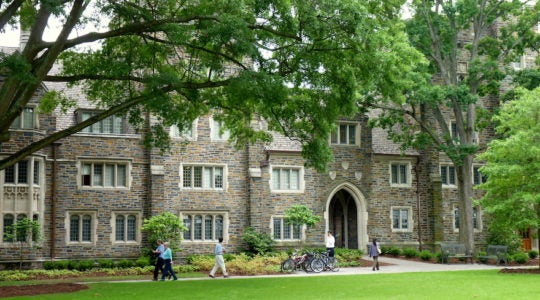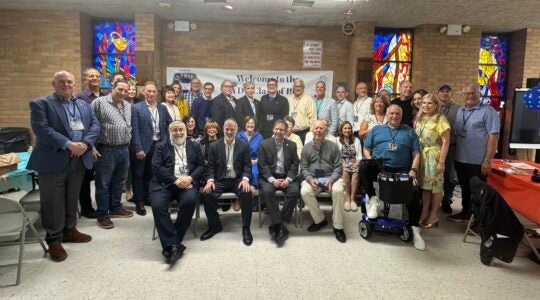In a black-and-white, undated photograph from an unidentified cheder in pre-World War II Europe, a row of young Jewish boys, caps on their heads, are sitting at wooden desks, brittle old books of Torah spread before them.
It was a familiar image for Rob Fried, who grew up in East Meadow, L.I.
He’d often visit his grandparents in Borough Park, the Brooklyn neighborhood where thousands of Holocaust survivors settled after the war ended and the death camps were liberated; his grandmother, Auschwitz survivor Rebecca Fried, would show him that picture. On a page of “Polish Jews,” a 1947 pictorial record of Europe’s lost Jewish culture, one boy, second from the right in the photo, his face a few inches from the Torah, was her younger brother, Simcha Weiss.
Simcha, who was growing up in a chasidic family in Czechoslovakia, died at 7 in Auschwitz, where Mrs. Fried’s parents also perished.
Two decades after he first saw the photograph of his deceased great-uncle, Rob Fried recognized that same photograph in 1983’s “A Vanished World” (Farrar, Straus and Giroux), Roman Vishniac’s instant-classic pictorial history of Jewish life in Germany and Eastern Europe before the war. Fried recognized that Vishniac — who traveled throughout Central and Eastern Europe several times on assignment from the Joint Distribution Committee between 1935 and 1938 — had assumed the unofficial role of the photographic chronicler of disappeared Jewish life in the Old Country. Vishniac had also produced the 1965 book “Polish Jews: A Pictorial Record.”
Fried contacted the International Center of Photography, in Manhattan, which last year hosted an exhibition about Vishniac’s work, and the U.S. Holocaust Memorial Museum, in Washington, a repository of Shoah artifacts, with information about the photograph of Simcha Weiss.
Both institutions thanked Fried for the information, and indicated that they would include the facts in future educational materials, said Fried, a computer forensic scientist who lives in Valley Stream, L.I.
More identification of faces in Vishniac’s photographs will likely take place in the next few years.
Last month, the ICP (icp.org) and the Museum (ushmm.org) announced a joint project that has digitalized more than 9,000 of Vishniac’s negatives (most of them not previously printed or published) and some 30,000 of his other assorted written materials, recordings and photographic records. The archival project is making all the items available, at no cost, at vishniac.icp.org, and is encouraging relatives of survivors — most likely, children and grandchildren — to contact either institution if they recognize people in the photographs, few of which contain any identifying details.
The missing names will add to the historical record of the Shoah era.
“Within a decade our ability to do this will run out,” said Maya Benton, curator of ICP’s Vishniac Archives, alluding to the survivor generation’s mortality. An authority on Vishniac since her graduate studies at Harvard University a decade ago, Benton is editor of “Roman Vishniac Rediscovered,” which will be published next year by ICP in conjunction with DelMonico Books/Prestel.
While Rob Fried reached out to ICP and the Museum last year, neither institution has yet been able to verify the information that survivors or survivors’ relatives have submitted of relatives’ identification information in the few weeks since the digitalized images went online, she said. The institutions have publicized the project through social media, survivor organizations, Jewish museums around the world, and other Jewish groups.
Though the website is only in English now, translators are available who can speak and read many languages, Benton said. The photographs, she said, are likely to draw more interest — especially among survivors’ descendants — than written history or similar documents. “Images are universal.”
“This project will introduce many people to one of the 20th century’s pre-eminent photographers while greatly increasing our understanding of his subjects,” said Michael Grunberger, director of collections at the Museum, in a statement. “We are excited to bring this collection to an even-wider audience,” said Mark Lubell, ICP executive director.
Michael Berenbuam, Holocaust scholar and author, called the archives project a “wonderful contribution [to Holocaust documentation]. Would that it was done 25 years ago, would that it was done 50 years ago” — when more survivors were alive. “Time is limited.”
The archival project follows a retrospective exhibition of Vishniac’s photographs at ICP last year; the traveling exhibition recently ended a four-month run at Amsterdam’s Jewish Historical Museum, and is to be hosted this month at Paris’ Museum of Jewish Art and History, then next year at Warsaw’s Museum of the History of Polish Jews (vishniac.icp.org/traveling-exhibition).
Vishniac, who was born in Russia in 1897 and then immigrated to the U.S. in 1940, died in 1990.
In Moscow he studied biology and zoology; though he spent much of his professional career as an expert in photomicroscopy and time-lapse photography, he is best known for the pictures he took of European Jewry.
According to a 2010 New York Times Magazine story about Vishniac, he intentionally shaped both his photographic images and the details of his past (indicating that he had set out through Europe on his own initiative, rather than on a JDC assignment; that he had selectively released only the most emotive photographs; that he was sometimes less than accurate in some images’ caption details.
The range and quality of Vishniac’s photographs are their own best witness, Benton said. “In both the exhibit and the book we deal with Vishniac’s evolving reception and legacy, and how the photographs have come to symbolize Jewish life in Eastern Europe. We have also been correcting misinformation and working to verify captions, dates and locations.
“The negatives are the negatives, they were not spliced, in-painted or manipulated in any way,” Benton said. “They represent what he saw and captured through his camera’s lens. The photographs/negatives … present a visual document of the people and towns that ceased to exist after the Holocaust.”
Vishniac, Benton said, “was a Jewish photographer” — it turns out he photographed the DP where her mother was as a child. “This is a very personal project. I grew up with his books,” Vishniac’s photographs serving as “visual reference points.”
In research at the Vishniac estate, Benton found that Vishniac, whose assignment was to document Jewish poverty, had taken pictures of Jews of various religious and economic levels, both rural and urban. “He was a very versatile photographer.”
Benton formed a friendship with the photographer’s daughter, Mara Vishniac Kohn, who is donating many items from her father’s estate to ICP. “She wanted to figure out how to best honor his legacy.”
The Center has partnered with the U.S. Holocaust Memorial Museum in creating the online archive, Benton said, because “ICP is not a Jewish institution. [The project] needed an interdisciplinary approach.”
The new online archive is similar to “Our Shared Legacy,” a three-year-old database of JDC documents, part of the organization’s Global Archives, which also encouraged survivors’ input in identifying faces in old photographs. (The website: jdc.org/sharedlegacy).
Linda Levi, director of the Global Archives, called Shared Legacy “a proven success. Thousands of people visited the site, making it actually the most popular feature on the JDC Archives website. Thousands have found documents that helped them in their genealogical and family history searches, primarily documents listing help extended by JDC to family members. We received many responses from people identifying family members in our photographs. Often, people were extremely grateful as they did not previously have photos of themselves and family members from this period.”
Rob Fried, who last year published “From Generation To …” (WingSpan Press), an illustrated book of his Holocaust-themed poetry and reproductions of family Holocaust-related documents (fromgenerationto.com), said the digitalized Vishniac Archives are an important tool in helping survivors complete the record of their wartime experiences.
“I think it’s really important that we [share] our grandparents’ stories,” he said.
His grandmother, now 86, who was one of the 4,515 passengers on the SS Exodus in 1947, still lives in Borough Park.
The Vishniac photograph of Simcha Weiss is the only picture she owns of her brother; Rob Fried made an enlargement of the photograph for his grandmother.
Framed, it now hangs on her living room wall.
The New York Jewish Week brings you the stories behind the headlines, keeping you connected to Jewish life in New York. Help sustain the reporting you trust by donating today.




